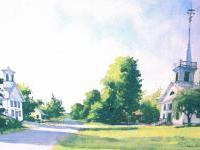Compton County Museum’s large and unique collections transport the visitors back to everyday life in the early homesteads and villages of Eaton Corner and Compton County in the 1800s. In December 1800, Eaton became a township which included Eaton Corner, Cookshire and Sawyerville, and by 1815, the population of Eaton Township was 600.
Eaton Corner, on the old Craig Road leading across the border, soon became a bustling stagecoach stop for those traveling between New England and Quebec. By mid-century, the crossroads was a busy and prosperous agricultural and commercial centre. Merchants, blacksmiths, tanners, milliners and seamstresses plied their trades, while innkeepers, doctors, teachers, and clergy served the needs of the growing community.
The collections of the Compton County Museum span the history of the area, from the early settlement period through the 1860s, when Eaton Corner was in its heyday. There are also objects from the turn of the 20th century, memorabilia from both World Wars, and glimpses of life in the 1940s and 50s.
The museum contains a wealth of photographic materials for researchers, including tintypes, textual materials in family collections, and records from local organizations, governments and schools.
 The houses in the village of Eaton Corner offer a glimpse into the community's past. Only one house in the village was built after 1908, and the typically American architectural styles reflect the origins of many of the early settlers.
The houses in the village of Eaton Corner offer a glimpse into the community's past. Only one house in the village was built after 1908, and the typically American architectural styles reflect the origins of many of the early settlers.
The Compton County Historical Museum Society has acquired most of its collections through donations by local families of the historic Compton County. What we see in the museum are the household objects, tools and equipment used in the everyday lives of those families.
The earliest settlers in the county were English speaking immigrants from the United States. Many descendants of those families still live in the region today, on both sides of the border.
This on-line exhibit represents only a very small sampling of the objects found in our collections. The best way to appreciate the richness of our collections is to visit the museum in person.